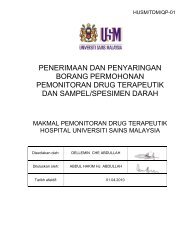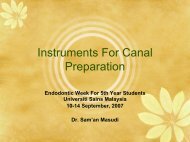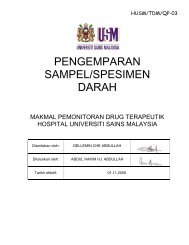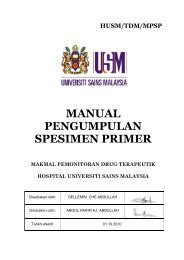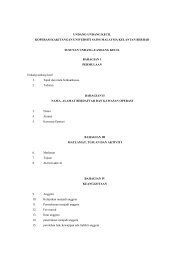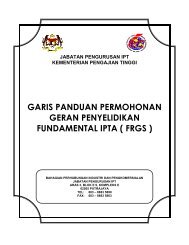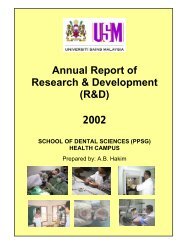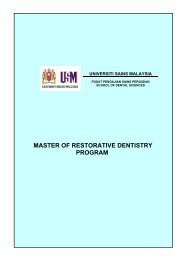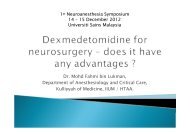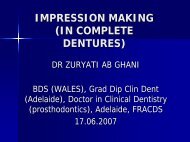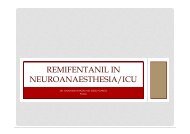Vol 11-R2- Eyelid
Vol 11-R2- Eyelid
Vol 11-R2- Eyelid
Create successful ePaper yourself
Turn your PDF publications into a flip-book with our unique Google optimized e-Paper software.
SRPS • <strong>Vol</strong>ume <strong>11</strong> • Issue <strong>R2</strong> • 2010<br />
a moisture chamber can help protect the cornea.<br />
Surgical intervention might be required as a<br />
definitive solution. The surgical approach depends<br />
on the cause of the lagophthalmos. If retraction<br />
occurs because of limited anterior lamellae (skin<br />
and orbicularis), repair is best accomplished with a<br />
full-thickness skin graft or adjacent advancement<br />
flap. Middle lamellar shortening can lead to eyelid<br />
retraction and inferior scleral show and can be<br />
treated with spacer grafts, such as tarsoconjunctival<br />
grafts, AlloDerm, ear cartilage, or hard palate grafts.<br />
Notching and Contour Deformities<br />
When reconstructing the eyelids, care must be<br />
taken to avoid creation of irregularities along<br />
the eyelid margin and to maintain the normal<br />
curvilinear contour of the upper and lower eyelids.<br />
Failure to accomplish this can lead to a cosmetically<br />
displeasing result and loss of the normal eyelid<br />
function regarding protection of the cornea and<br />
facilitation of a functional tear drainage system.<br />
A notching defect can occur when the eyelid<br />
margin is not adequately everted during its repair.<br />
Contraction of the wound during healing leads to<br />
a notch in the normally smooth and continuous<br />
eyelid margin. Notching is also common if wound<br />
dehiscence occurs. Such dehiscences can occur<br />
from excessive wound tension or from infections.<br />
It is a common complication if the closure of the<br />
wound does not include the tarsus in the margin or<br />
anterior surface sutures. By disrupting the normal<br />
lash line, eyelashes can be turned inward, leading to<br />
localized trichiasis. Patients encounter foreign body<br />
sensation and corneal irritation leading to epiphora,<br />
abrasion, infection, and possible perforation of the<br />
globe. Additionally, the notch formed can lead to<br />
inappropriate coverage of the cornea, leading to<br />
corneal exposure and associated complications that<br />
are discussed later in this section. Removal of the<br />
eyelid notch is typically achieved by a simple wedge<br />
resection and marginal eyelid repair. Additionally,<br />
manual epilation of the in-turned eyelashes can help<br />
temporize the situation.<br />
Maintaining the normal curvilinear contour<br />
of the eyelid is essential not only for a cosmetically<br />
42<br />
acceptable result but also to ensure proper drainage<br />
of tears. If the lateral or medial canthal tendons<br />
are not adequately fixated at the lateral and medial<br />
orbital rims, the eyelid will not have appropriate<br />
tension to allow the orbicularis muscles to exert<br />
pressure along the canaliculi and tear sac, which is<br />
crucial for the active drainage of tears. Additionally,<br />
without proper tension on the eyelid, ectropion can<br />
result, as discussed above.<br />
Blepharoptosis<br />
Blepharoptosis occurring after eyelid reconstruction<br />
can be caused by the initial trauma or tumor or by<br />
the surgical repair itself. A ptotic eyelid, in addition<br />
to being a cosmetic concern, might interfere with<br />
the central visual axis. The complication becomes<br />
even more serious in pediatric patients when the<br />
development of amblyopia is a possibility.<br />
The normal anatomy of the eyelid must<br />
be carefully considered when attempting eyelid<br />
reconstruction. The preaponeurotic fat serves as<br />
one of the most important surgical landmarks in<br />
eyelid reconstruction. Just posterior to the fat lies<br />
the levator aponeurosis, which can easily be severed.<br />
Additionally, extensive tissue swelling can lead<br />
to dehiscence of the levator aponeurosis from its<br />
attachment to the tarsus.<br />
Repair of ptosis after eyelid reconstruction<br />
should be delayed at least 6 months and sometimes<br />
longer if serial examinations reveal improvement<br />
in eyelid position. Surgical repair is aimed at<br />
reattaching or advancing the levator aponeurosis<br />
along the tarsus. If reattachment is not possible, or<br />
if the levator function is poor, a brow suspension<br />
procedure might be necessary.<br />
Epiphora<br />
Excessive tearing and increased tear lake cause<br />
distorted vision by disrupting the normal<br />
tear-cornea interface. Irritation and maceration<br />
of the periocular skin occur because of the<br />
prolonged wetness.<br />
Commonly, medial canthal defects result in<br />
injury to the canalicular system, disturbing the<br />
normal drainage of tears. Repair should include



